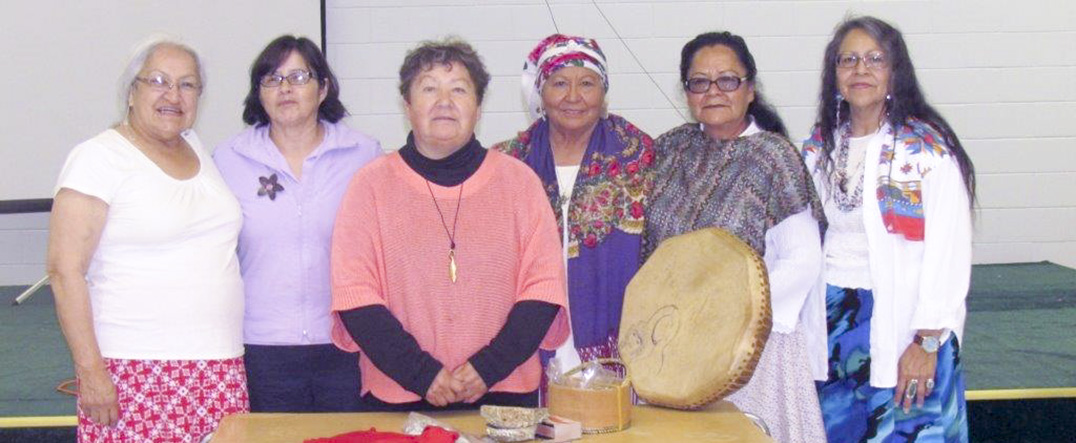by Betty Bardswich
M’CHIGEENG—An international council of 13 aboriginal female elders was founded in the United States in 2004. Named the Thirteen Indigenous Grandmothers of the World, the group focusses on issues such as the environment and human rights and seeks to learn about each other’s culture. The elders come from the United States, Brazil, Mexico, New Zealand, Tibet and Africa. The organization meets every six months and also visit each other’s homeland.
The Island had the privilege of hosting one of the grandmothers on June 8 and 9 as Margaret Behan of Montana was a guest speaker at an assembly at the community complex in M’Chigeeng titled ‘Gathering of our Elders.’ The event was sponsored by the Ojibwe Cultural Foundation (OCF) in M’Chigeeng and the Noojmowin Teg Health Centre in Aundeck Omni Kaning First Nation and also featured story teller, healer and social worker Isabelle Measwige.
On June 9, the gathering began with the passing of a feather from person to person with each one saying a word. These words ranged from appreciate, honour, observation, ecstatic to be here, privilege, happy to thank you, thank you, thank you. “There is teaching in every word that was said,” seminar coordinator Roberta Oshkawbewisens explained. “I was always told that grandmothers are the teachers,” she added, “I am always learning from them.”
Ms. Measwige is an elder from Serpent River First Nation and she and her business partner started a sanctuary named Wharmcliffe Retreat and Learning Centre in the Mississagi river valley near Sault Saint Marie. Her mission is to support the work of the 13 Grandmothers.
“The work that I do,” Ms. Measwige told her audience, “is what I call stress management and it is based on foot soak, meditation and stress management. A lot of this we need as we are in a lot of stress. We carry stress in our bodies, in our arms. We lift up a lot of heaviness that we are carrying.”
Elder Behan is a resident of a reservation in Montana and asked her audience to carve their own world out of this beautiful place we call Manitoulin. “Your land here is beautiful,” she said as she went on to say that a 13 Grandmothers teaching from Canada originated on the Island. She also explained that the council joined with the Center for Sacred Studies in 2004. The mission statement of this organization, based in Guerneville, California, states that its members are dedicated to sustaining ways of life based on collaboration and reciprocity with the Earth and Her beings.
Ms. Behan spoke of her travels as a member of the council which included trips to Australia, Africa and Tibet. “In Tibet,” she noted, “we went through the security system to see the Dalai Lama and he had guards and they had machine guns. This was mind blowing for me.”
Grandmother Behan also involved her audience in discussion, asking at one point, about the significance of the number 13. The answers ranged from the fact that there are 13 moons in one year to the 13 stars on the Blessed Mother’s crown to the 13 spokes made out of rocks in Saskatoon and Wyoming that are thousands of years old. Levi Debassige pointed out that a lot of people are afraid of the number 13 and consider it so unlucky that people will not have a thirteenth floor in high-rises, but just go from 12 to 14. It was also explained by Ms. Behan that there are 12 apostles with the number 13 being God.
The audience was also asked the question, “What are you doing right now?” by Ms. Behan, who added, “What are you doing about it?” when an audience member said that First Nations people are number one for suicide and sexual assaults. “I am here learning,” a woman responded, “and I am attending a meeting tomorrow about the sexual assaults at Wiky. These men have to be accountable. And the police have to step up. I am also starting a narcotics anonymous group.”
Another woman spoke about the work she is doing by making a vamp, the top part of a moccasin, by putting the M’Chigeeng Health Centre on her vamp. “The vamp movement,” she explained, “is to remind us about our missing and murdered women.”
Mary Lou Debassige also spoke, saying, “I want to say about the Idle No More movement. I was asked to do a circle for that in Espanola. The unity, the support that was in there. We belong in a circle, a circle of life. Standing up for each other. Sharing with each other. I was honoured to participate in this Idle No More movement.”
Elder Alma Jean Migwans also answered the question about participation. “We have to go back to the sacred teachings,” she said. “We have to look at ourselves. Where did we get lost? Why don’t we have the fires anymore and sit around and burn tobacco? We have to acknowledge our sacred beings. Every spring we go to the four corners of our place. We go out in the coldest day in February to Lake Mindemoya to appease our sacred beings.”
Sophie Corbiere, another coordinator at the gathering, spoke of Ms. Behan’s journey and the healing taking place as well as for First Nations people to help themselves. It is expected that there will be another gathering in the fall.






